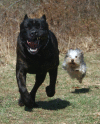Canine morphology: hunting for genes and tracking mutations
- PMID: 20209140
- PMCID: PMC2830451
- DOI: 10.1371/journal.pbio.1000310
Canine morphology: hunting for genes and tracking mutations
Abstract
In this essay, Abigail Shearin and Elaine Ostrander discuss the proposed genomic mechanisms for the extraordinary level of phenotypic variation observed in the domestic dog and the evidence detailing the variants responsible for the many shapes, sizes, textures, and colors of man's best friend.
Conflict of interest statement
The authors have declared that no competing interests exist.
Figures




References
-
- Darwin C. Origin of spcies by means of natural selection. London: John Murray; 1859.
-
- Sutter N. B, Ostrander E. A. Dog star rising: the canine genetic system. Nat Rev Genet. 2004;5:900–910. - PubMed
-
- Ostrander E. A, Wayne R. K. The canine genome. Genome Res. 2005;15:1706–1716. - PubMed
-
- Wayne R. K, Ostrander E. A. Lessons learned from the dog genome. Trends Genet. 2007;23:557–567. - PubMed
-
- Ostrander E. A. Genetics and the shape of dogs. Amer Sci. 2007;95:406–413.
Publication types
MeSH terms
Grants and funding
LinkOut - more resources
Full Text Sources

